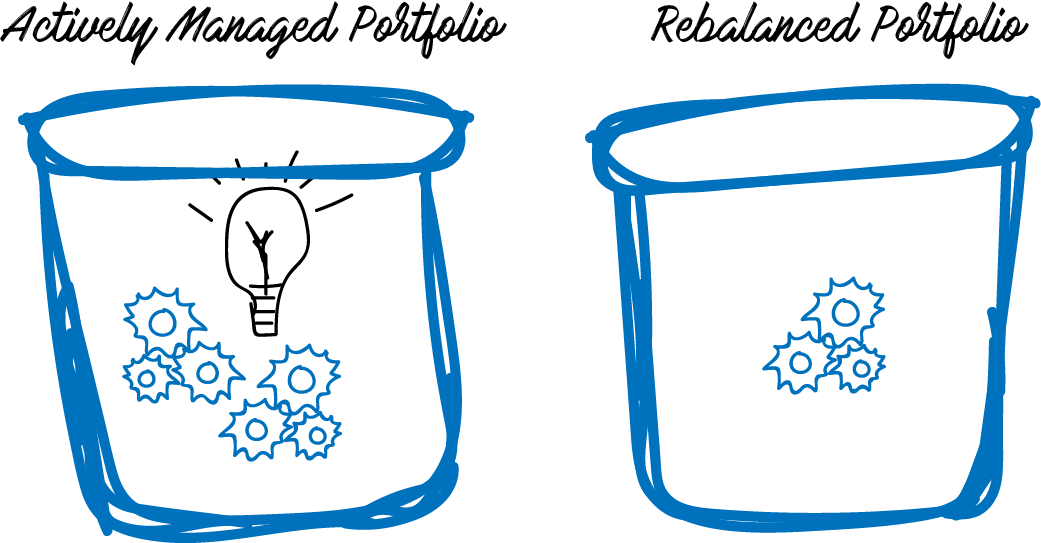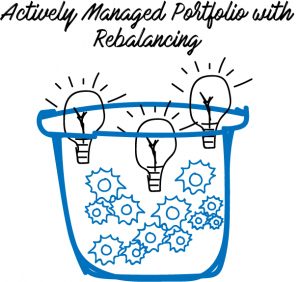Rebalancing and Active Management are two different concepts with two different objectives. Spectrum’s AssetMaxxSM and AssetMaxxGOSM services employ both. Rebalancing has the goal of keeping a standard asset allocation, or portfolio mix, constant despite the changing market conditions based only on investment objectives and personal profiles. Active Management exists to protect from losses, takes advantage of short term opportunities, and safe guards the portfolio during extreme periods of loss. Spectrum Financial believes in using active management and rebalancing: Rebalance the client account with actively managed mutual funds. We chose to be active investment managers since our inception of managing client assets in 1986. Moving client assets in and out of the market, or from one asset class that is losing momentum to another that is gaining momentum, has allowed us to be successful. Managing risk is priority over making money, and active management allows us to achieve results. The Spectrum Funds and the Hundredfold Select Alternative Fund used in our AssetMaxxSM and AssetMaxxGOSM services were created by Ralph Doudera and our investment team to be held as a core investment. The Funds are active and constantly being managed to take advantage of market opportunities and safe guard from unnecessary risk.
Understanding Rebalancing
No matter what investment methodology you or your investment advisor choose, your portfolio mix is first defined by your risk tolerance, financial goals and age. Your portfolio mix could look like any one of the following:
- 60% bonds and 40% equity
- 50% bonds and 50% equity
- 25% bonds, 50% equity, 25% alternatives
- 100% equity
- 100% bonds
Your allocation truly is personalized to you. Let’s say that your portfolio mix is 60% equity exposure and 40% bond exposure and that was your set allocation for the last 10 years. Over the last 10 years the equity market has greatly outperformed the bond market. Your 60% equity piece would have seen a lot of growth and if your account was not periodically rebalanced your equity exposure could look more like 80% and bond exposure 20%. The higher equity exposure has raised your risk compared to your original 60%/40% allocation. If the opposite happened and the equity market experienced extreme drawdowns while the bond market experienced growth over those 10 years, then going forward you would have less equity exposure and potentially miss out on making more profits as the equity market rallied (or went up). Rebalancing sets parameters on your portfolio and makes sure it stays correctly allocated until your investment objectives and goals change.
- You have a 60% equity and 40% bond portfolio
- After the equity market experienced a rally, your portfolio allocation is 68% equity and 32% bond
- To rebalance your portfolio back to 60% equity and 40% bond, an 8% exchange would take place between the equity exposure and the bond exposure
- 8% sell of equity exposure would be created and then once settled, 8% buy towards bond exposure would be created
Rebalancing can be set to any number of time periods: quarterly, annually, daily, monthly, etc. The motivation between rebalancing is to keep the same portfolio mix for the client throughout the desired time frame and to somewhat manage risk. Rebalancing, however does not safeguard against losses, bear markets, etc within each asset class (equities, bonds, alternatives , etc). For example, if your portfolio mix was 60% equities and 40% bonds during 2008, the rebalance parameters on your account were annual, and you chose to use index funds or mutual funds not actively managed, here is the loss you may have experienced using only the S&P 500 TR Index as your example of equity exposure and the Lipper High Yield Bond Index as your bond example (you cannot directly invest in an index).
- $100,000 account is set to a 60% equity 40% bond allocation
- In 2008, the S&P 500 TR Index experienced a loss of – 37.00 %
- $60,000 (equity piece) would look like $37,800
- In 2008, the Lipper High Yield Bond Index experienced a loss of –28.8%
- $40,000 (bond piece) would look like $28,480
- Total account value in 2008 would be $66,280
- Total portfolio performance for 2008 would be – 33.72%, despite “rebalancing” only
Spectrum Financials’ Active Management
Active Management sets parameters on your portfolio and makes sure it stays correctly allocated until your investment objectives and goals change AND protects against extreme losses compared to its asset classes and benchmarks because of the actively managed mutual funds created by Ralph for Spectrum and Hundredfold.
Below is an example of a portfolio using active management in tandem with rebalancing. For this example, 60% of the portfolio’s allocation will reflect an actively managed equity fund and 40% of the portfolio will reflect an actively managed fixed income fund. For more information and performance of these specific funds, please contact our office.
- $100,000 account is set to a 60% actively managed equity 40% actively managed fixed income
- In 2008, the actively managed equity fund was down –22.8%
- $60,000 (equity piece) would look like $46,320
- In 2008, the actively managed alternative fund experienced a loss of –12.24%
- $40,000 (bond piece) would look like $35,104
- Total account value in 2008 would be $81,424
- Total portfolio performance for 2008 would have incurred less loss at –18.56% !
Using rebalancing and active management together could make your investment experience less volatile. Roller coasters are great for amusement parks but not your investments!
Spectrum and Hundredfold’s use of active management in their mutual funds asses the market on a daily basis and make investment decisions actively to both take advantage of market opportunities and to safeguard client’s assets.
Spectrum exists for one reason: to safeguard our client’s assets while attempting to make them money. We have been managing client assets for over 30 years through all sorts of market environments. Over those 30 years we continually prefect, learn and test the best methods to achieve our client’s goals. Rebalancing and Active Management are different, but when used together they can achieve more than one objective!



